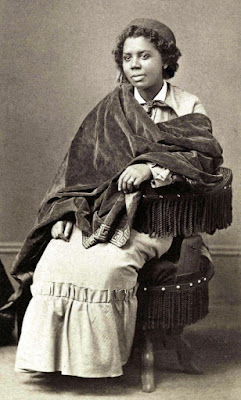by Brenna Corbit, Technical Services Librarian
In the past I have explained advance searches using filters for place of birth, vital record dates, residence, etc. Other search filters include “Race/Nationality.” With these filters you can narrow down to race, ethnicity, and nationality, but therein may be confusion.
African Americans
If you are researching your African American roots, keep the following in mind. Sometimes an index yields different results with negro, colored, mulatto or black. Ancestry and other family history databases are matching information recorded on forms from the period. Terms such as African-American came much later.
However, I have noticed, lately, that “African American” has been added as a searchable term, too. Therefore, if you are researching your black roots, try different race terms. Also keep in mind that light skinned people may be listed as white. I have seen the same person come up in different records with all four race descriptions. Also be aware that when searching period newspapers and histories, the N word was often used. Past publications were often quite racist.
If your ancestor is Black/American Indian, you may have to search under separate terms. I encountered this when helping someone with their Native/African American roots. The families were showing up interchangeably in records as either “Indian,” “black,” or “negro.”
Europeans
If your ancestor is Black/American Indian, you may have to search under separate terms. I encountered this when helping someone with their Native/African American roots. The families were showing up interchangeably in records as either “Indian,” “black,” or “negro.”
Europeans
You can be a white Pole with your nationality being Russian, for example. Pre-1918 records for Poles will state either Austrian, Prussian or Russian due to the 100 years partition when Poland was wiped of the map. Also keep in mind that records for these three partitions can also state Ruthenian, German, Galycian, or Jewish when speaking of ethnicities.
Other European countries were also in flux, but probably not as much as Eastern Europe. In the 1800s a person identifying ethnically as Irish was also a British subject. Germany was once divided into several kingdoms—Bavaria, Baden, Saxony, Prussia, to name a few. I could present many other examples. Research your ancestor’s country’s history to understand the differences between ethnicity and nationality. The world map was and is always changing. The following link of a 1000-year time lapse of Europe’s changing borders illustrates my point.
Other Countries and Ethnicities
Other Countries and Ethnicities
I admit that I know very little concerning other countries and ethnicities, but the same rules can be applied. I have recently looked at a Chinese family history in early Hawaii. Ethnically they were Chinese, but nation-wise they were Hawaiian. I have also seen yellow and red as racial index descriptors.
Immigration Records
Immigration Records
While most records only ask race, ship manifests often had separate columns for ethnicity and nationality, and place of birth, especially those of the early 1900s.
 |
A
ship’s manifest from 1913. Note the
columns for
nationality, race, and residence. The second page
(not shown) also includes a column for place of birth.
Source:
Ancestry.com
|
If you are having trouble, try not using a race/nationality filter. As I said, many race descriptors change with the same person, and I have often seen indexing errors. I have also mentioned in the past to try casting a larger net rather than using too many search filters. The latter can often yield nothing. No one method is correct. Keep trying different search strategies.


No comments:
Post a Comment